Spring 组合注解的处理
Spring 组合注解的处理
一、什么是组合注解?
在spring中,有一类特别的注解:组合注解。举例来说,springmvc中,@Controller注解用来配置访问路径等,@ResponseBody 注解用来表明不做视图渲染,直接展示方法的运行结果(一般是转成json返回),而@RestController组合了两者的功能,可以配置访问路径,同时也可以直接展示方法的运行结果,代码如下:
@ResponseBody
public @interface RestController {
/**
* 注解别名
*/
@AliasFor(annotation = Controller.class)
String value() default "";
}
可以看到,@RestController上标记了两个注解:@Controller与@ResponseBody,这样它就同时拥有了两者的功能。
再来看一个例子,spring中,我们在标识一个类为spring bean的时候,可以用到这些注解:@Component、@Repository、@Service等,再进一步看其代码,发现@Repository、@Service中都有@Component:
@Component
public @interface Repository {
@AliasFor(annotation = Component.class)
String value() default "";
}
@Component
public @interface Service {
@AliasFor(annotation = Component.class)
String value() default "";
}
也就是说,@Repository、@Service都组合了@Component的功能!
实际上,如果我们自己写一个注解,像这样:
@Target({ElementType.TYPE})
@Retention(RetentionPolicy.RUNTIME)
@Documented
@Component
public @interface MyComponent {
@AliasFor(annotation = Component.class)
String value() default "";
}
然后这样使用:
@MyComponent("beanObj3")
public class BeanObj3 {
...
}
spring 依然会把BeanObj3初始化为spring bean。
那么spring是如何做到这一步的呢?实际上,spring在处理@MyComponent时,会判断该注解中是否包含@Component注解,如果包含,就获取该注解的配置,然后按@Component的处理逻辑来进行处理。
同样地,spring在处理@RestController时,如果当前是处理@Controller的逻辑,就从@RestController中获取@Controller的配置然后进行处理,如果当前是处理@ResponseBody逻辑,就从@RestController中获取@ResponseBody的配置然后进行处理。
二、递归获取指定类的所有注解
问题又来了:组合注解中的注解要怎么获取呢?
如果按照jdk提供的方法,像这样:
RestController annotation = BeanObj3.class.getAnnotation(MyComponent.class);
得到的annotation必定为null,原因是Class#getAnnotation方法只能获取到类上直接出现的注解,BeanObj3是没有直接出现@Component的,因此得到的结果为null,办法也许你也想到了,就是继续往下读取"注解的注解",用代码示意下,类似这样:
public class AnnotationHandler {
/**
* 存放jdk提供的元注解
*/
private static Set<Class<?>> metaAnnotations = new HashSet<>();
static {
metaAnnotations.add(Target.class);
metaAnnotations.add(Documented.class);
metaAnnotations.add(Retention.class);
}
public static void main(String[] args) {
List<Class<?>> list = getAnnotations(BeanObj3.class);
System.out.println(list);
}
/**
* 获取操作,递归调用
*/
public static List<Class<?>> getAnnotations(Class<?> cls) {
// 用来存放该类上的所有注解,包括注解的注解
List<Class<?>> list = new ArrayList<>();
// 调用 doGetAnnotations(...) 获取
doGetAnnotations(list, cls);
return list;
}
/**
* 获取注解的具体操作
*/
private static void doGetAnnotations(List<Class<?>> list, Class<?> cls) {
// 获取所有的注解
Annotation[] annotations = cls.getAnnotations();
if(annotations != null && annotations.length > 0) {
for(Annotation annotation : annotations) {
// 获取注解的类型
Class<?> annotationType = annotation.annotationType();
// 过滤jdk提供的元注解
if(metaAnnotations.contains(annotationType)) {
continue;
}
// 递归调用
doGetAnnotations(list, annotationType);
}
}
// 如果是注解,就添加到 list 中
if(cls.isAnnotation()) {
list.add(cls);
}
}
}
我们要获取BeanObj3上所有注解,就可以这样操作了:
// 得到 BeanObj3 上的所有注解,包括“注解的注解”
List<Class<?>> list = AnnotationHandler.getAnnotations(BeanObj3.class);
// 判断 BeanObj3 的注解中是否包含 @Component
list.contains(Component.class);
以上demo还是比较粗糙,首先是jdk的元注解,这里只排除了三个,这三个都是在@Component中出现的,处理@Component之上的注解读取已经足够了;其次也是最重要的,就是没有获取注解的数据。在spring中,注解并不只是一个标记,还可以定义一系列数量,像这样:
// 定义 spring bean 的名称为 beanObj3
@MyComponent("beanObj3")
public class BeanObj3 {
...
}
而AnnotationHandler并不能获取到注解的数据!
接下来我们来看看spring是怎么做到注解数据的读取的。
三、spring 读取注解信息
spring 5.2 中,对于注解信息的读取有提供了三个类:
AnnotationMetadataReadingVisitor:注解数据的读取类,基于asm实现,不过在spring5.2中已经废弃(标记了@Deprecated),建议使用SimpleAnnotationMetadataReadingVisitor,因此本文不作分析SimpleAnnotationMetadataReadingVisitor:注解数据的读取类,基于asm实现,spring 5.2 中新增的类,用于替代AnnotationMetadataReadingVisitor,需要注解的是,SimpleAnnotationMetadataReadingVisitor的访问级别是默认的,无法在所在包之外访问,同时它也是final的,不能被继承,因此我们无法直接操作它,不过spring提供了一个类:SimpleMetadataReaderFactory,通过它就可以使用SimpleAnnotationMetadataReadingVisitor了StandardAnnotationMetadata:注解数据的读取类,基于反射实现
3.1 SimpleAnnotationMetadataReadingVisitor
spring 并没有提供直接操作SimpleAnnotationMetadataReadingVisitor的机会,而是封装到 SimpleMetadataReaderFactory 了,我们先来看看这个类:
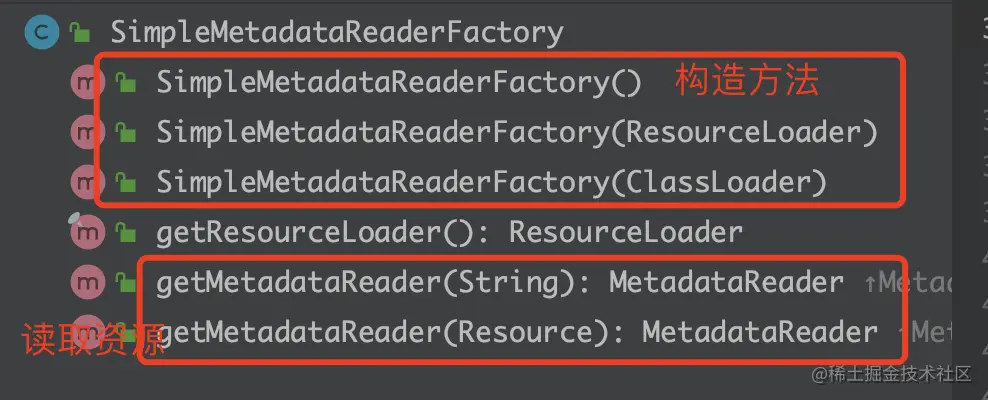
可以看到,SimpleMetadataReaderFactory的类主要分为两部分:
- 构造方法
- 资源的获取
这里我们直接看获取的获取,也就是getMetadataReader(...)方法:
getMetadataReader(Resource resource): 根据Resource读取数据 getMetadataReader(String className): 根据类名读取数据,传入的是全限定类名(即“包名.类名”),从代码来看,这个类名最终也会转化为Resource,然后调用getMetadataReader(Resource)进行读取
这两个方法的返回值都是MetadataReader,这是个啥呢?我们继续往下看.
3.1.1 MetadataReader
MetadataReader 的部分方法如下:
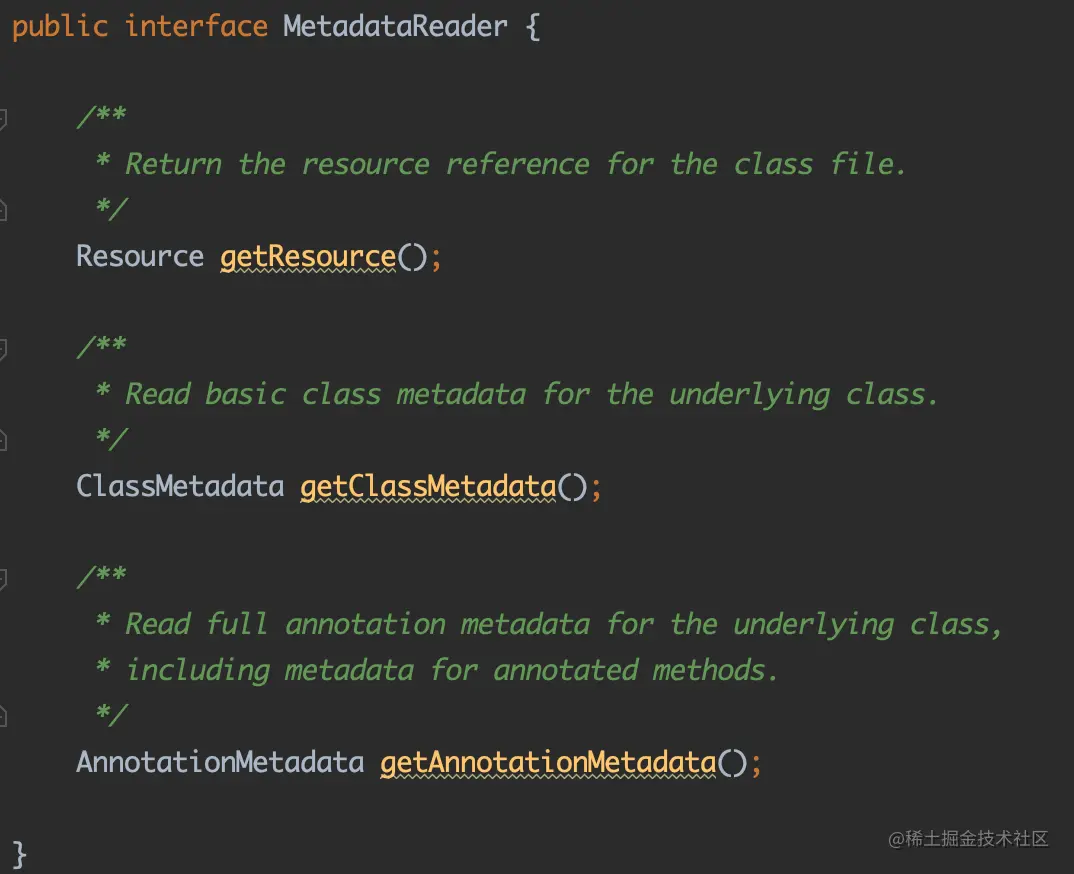
可以看到,它是个接口(这里返回的具体类型就是SimpleMetadataReader了),里面就3个方法:
getResource(): 获取资源getClassMetadata(): 获取类的元数据getAnnotationMetadata(): 获取注解的元数据
由于是获取注解的信息,这里我们只关注getAnnotationMetadata()方法:
java
复制代码AnnotationMetadata getAnnotationMetadata();
这个方法返回的是AnnotationMetadata,这又是个啥?
3.1.2 AnnotationMetadata
先来看看它的方法:
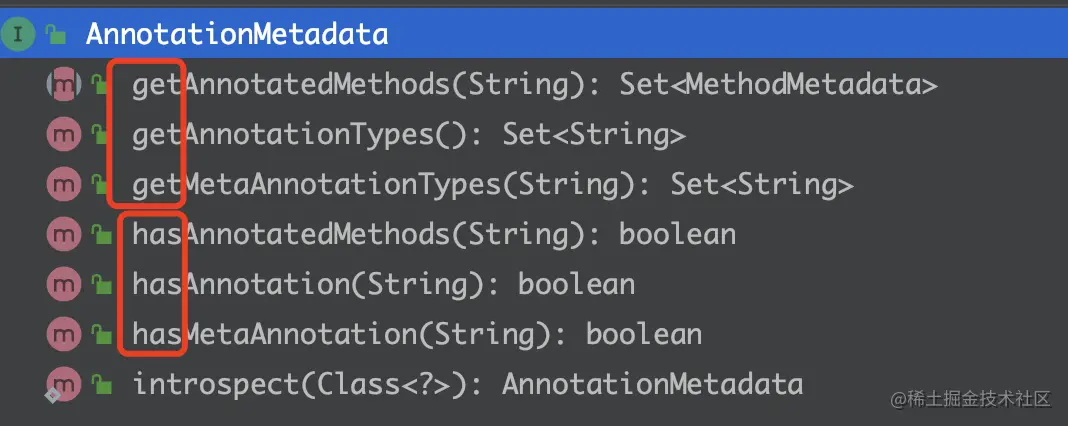
这些方法分为两类:
getXxx(...):根据注解获取对应的信息hasXxx(...):判断是否包含某注解
如果进一步看这几个方法的默认实现,发现都调用getAnnotations()方法:
public interface AnnotationMetadata extends ClassMetadata, AnnotatedTypeMetadata {
default Set<String> getAnnotationTypes() {
// 调用了 getAnnotations()
return getAnnotations().stream()
.filter(MergedAnnotation::isDirectlyPresent)
.map(annotation -> annotation.getType().getName())
.collect(Collectors.toCollection(LinkedHashSet::new));
}
default Set<String> getMetaAnnotationTypes(String annotationName) {
// 调用了 getAnnotations()
MergedAnnotation<?> annotation = getAnnotations().get(annotationName,
MergedAnnotation::isDirectlyPresent);
if (!annotation.isPresent()) {
return Collections.emptySet();
}
return MergedAnnotations.from(annotation.getType(), SearchStrategy.INHERITED_ANNOTATIONS)
.stream()
.map(mergedAnnotation -> mergedAnnotation.getType().getName())
.collect(Collectors.toCollection(LinkedHashSet::new));
}
default boolean hasAnnotation(String annotationName) {
// 调用了 getAnnotations()
return getAnnotations().isDirectlyPresent(annotationName);
}
...
}
再进一步查看getAnnotations()方法,进入了AnnotatedTypeMetadata:
public interface AnnotatedTypeMetadata {
/**
* 获取注解
*/
MergedAnnotations getAnnotations();
...
}
这一样看,似乎注解得到的终极类就是MergedAnnotations了?我们继续探索。
3.1.3 MergedAnnotations
MergedAnnotations的部分注释如下:
Provides access to a collection of merged annotations, usually obtained from a source such as a {@link Class} or {@link Method}.
提供对组合注解的集合的访问,这些注解通常是从Class或Method之类的来源获得的。
看来,MergedAnnotations 才是最终的组合注解的集合了,我们来看看它的几个方法:
// 判断注解是否存在,会从所有的注解中判断
<A extends Annotation> boolean isPresent(Class<A> annotationType);
// 判断注解是否存在,会从所有的注解中判断,与上面的方法不同的是,这里传入的是字符串
boolean isPresent(String annotationType);
// 判断直接注解是否存在,也就是只判断当前类上有没有该注解,不判断注解的注解
<A extends Annotation> boolean isDirectlyPresent(Class<A> annotationType);
// 功能同上,这里传入的类型是字符串,格式为"包名.类名"
boolean isDirectlyPresent(String annotationType);
// 获取注解
<A extends Annotation> MergedAnnotation<A> get(Class<A> annotationType);
// 获取注解,这里传入的类型是字符串,格式为"包名.类名"
<A extends Annotation> MergedAnnotation<A> get(String annotationType);
从方法上大致可以看出,MergedAnnotations是组合注解的集合,提供的注解可以判断某注解是否存在,也可以获取其中的某个注解。
3.1.5 MergedAnnotation
MergedAnnotations 是注解的集合,那这个集合中放的是啥呢?从它的get(...)方法来看,它存放的是MergedAnnotation,我们再来看看MergedAnnotation支持的方法:
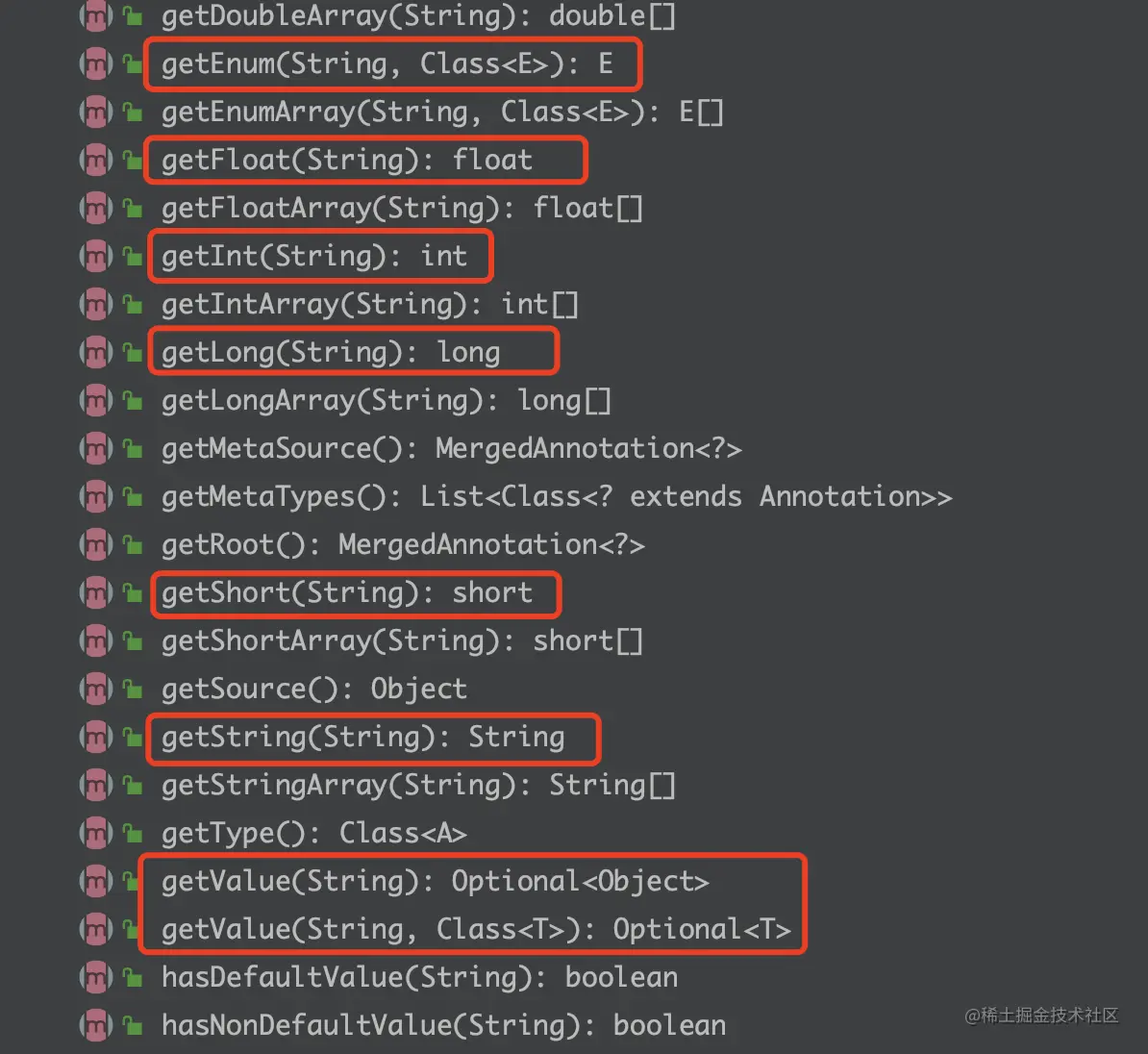
从以上的方法可以看到,MergedAnnotation 就是注解的数据抽象,它提供了丰富的api用来获取注解的数据。
3.1.6 使用示例
下面来看个示例:
// 得到 SimpleMetadataReaderFactory 实例,最终调用的是 SimpleAnnotationMetadataReadingVisitor 来读取
SimpleMetadataReaderFactory readerFactory = new SimpleMetadataReaderFactory();
MetadataReader metadataReader = readerFactory.getMetadataReader(BeanObj3.class.getName());
AnnotationMetadata annotationMetadata = metadataReader.getAnnotationMetadata();
// AnnotationMetadata 提供了许多的操作,重点关注注解相关的
Set<String> annotationTypes = annotationMetadata.getAnnotationTypes();
System.out.println("-------------");
annotationTypes.forEach(type -> System.out.println(type));
System.out.println("-------------");
// 这里是直接获取,BeanObj3 上直接标记 @MyComponent的,返回的是true
boolean exist1 = annotationMetadata.hasAnnotation(MyComponent.class.getName());
System.out.println("hasAnnotation @MyComponent:" + exist1);
// 这里是直接获取,BeanObj3 上是没有直接标记 @Component的,返回的是false
boolean exist2 = annotationMetadata.hasAnnotation(Component.class.getName());
System.out.println("hasAnnotation @Component:" + exist2);
// 获取 MergedAnnotations
MergedAnnotations annotations = annotationMetadata.getAnnotations();
System.out.println("-------------");
annotations.forEach(annotationMergedAnnotation -> System.out.println(annotationMergedAnnotation));
System.out.println("-------------");
// 这里是直接获取,BeanObj3 上是没有直接标记 @Component的,返回的是false
boolean directlyPresent = annotations.isDirectlyPresent(Component.class);
System.out.println("directlyPresent Component:" + directlyPresent);
// 判断有没有这个注解,BeanObj3 上的@MyComponent中,标记了 @Component 的,返回的是true
boolean present = annotations.isPresent(Component.class);
System.out.println("present Component:" + present);
// 获取 @Component 注解
MergedAnnotation<Component> mergedAnnotation = annotations.get(Component.class);
// 由于 @MyComponent 的 value() 加了 @AliasFor(annotation = Component.class)
// 因此这里得到的 value 是 beanObj3 (BeanObj3里这么指定的:@MyComponent("beanObj3"))
String value = mergedAnnotation.getString("value");
System.out.println("Component value:" + value);
// 将 @Component 的注解的数据转换为 AnnotationAttributes
AnnotationAttributes annotationAttributes = mergedAnnotation.asAnnotationAttributes();
System.out.println(annotationAttributes);
运行,结果如下:
-------------
org.springframework.learn.explore.demo01.MyComponent
-------------
hasAnnotation @MyComponent:true
hasAnnotation @Component:false
-------------
@org.springframework.learn.explore.demo01.MyComponent(value=beanObj3)
@org.springframework.stereotype.Component(value=beanObj3)
@org.springframework.stereotype.Indexed()
-------------
directlyPresent Component:false
present Component:true
Component value:beanObj3
{value=beanObj3}
3.1.7 补充:AnnotationAttributes
补充说明下AnnotationAttributes:
public class AnnotationAttributes extends LinkedHashMap<String, Object> {
...
}
它实现了LinkedHashMap,提供的部分方法如下:
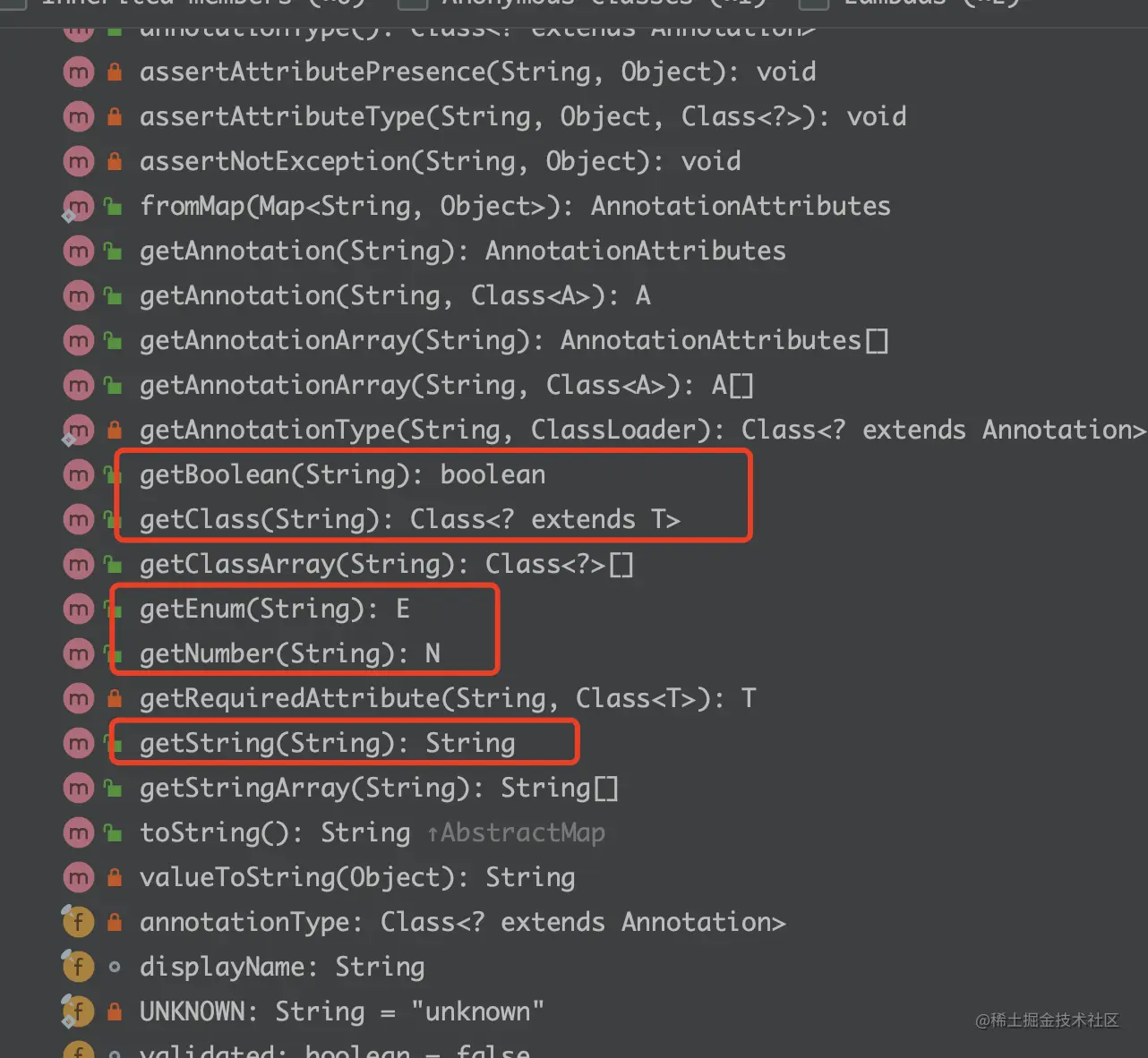
从这里不难看出,AnnotationAttributes就是包含注解所有属性值的map,key为属性名,value为属性值。
3.2 StandardAnnotationMetadata
我们接着来看看StandardAnnotationMetadata:
public class StandardAnnotationMetadata extends StandardClassMetadata
implements AnnotationMetadata {
/**
* Create a new {@code StandardAnnotationMetadata} wrapper for the given Class.
* @param introspectedClass the Class to introspect
* @see #StandardAnnotationMetadata(Class, boolean)
* @deprecated since 5.2 in favor of the factory method
* {@link AnnotationMetadata#introspect(Class)}
*/
@Deprecated
public StandardAnnotationMetadata(Class<?> introspectedClass) {
this(introspectedClass, false);
}
...
}
StandardAnnotationMetadata实现了AnnotationMetadata接口,对于注解的操作与上面介绍的AnnotationMetadata并无太大区别,这里就不赘述了。
从StandardAnnotationMetadata的构造方法来看,它已经废弃了,让我们使用AnnotationMetadata#introspect(Class)来获取StandardAnnotationMetadata的实例,于是,我们可以像这样来操作:
// 获取到的 annotationMetadata 实际上是 StandardAnnotationMetadata
AnnotationMetadata annotationMetadata = AnnotationMetadata.introspect(BeanObj3.class);
//----------- 以下内容与SimpleAnnotationMetadataReadingVisitor 一模一样
// AnnotationMetadata 提供了许多的操作,重点关注注解相关的
Set<String> annotationTypes = annotationMetadata.getAnnotationTypes();
System.out.println("-------------");
annotationTypes.forEach(type -> System.out.println(type));
System.out.println("-------------");
// 这里是直接获取,BeanObj3 上直接标记 @MyComponent的,返回的是true
boolean exist1 = annotationMetadata.hasAnnotation(MyComponent.class.getName());
System.out.println("hasAnnotation @MyComponent:" + exist1);
// 这里是直接获取,BeanObj3 上是没有直接标记 @Component的,返回的是false
boolean exist2 = annotationMetadata.hasAnnotation(Component.class.getName());
System.out.println("hasAnnotation @Component:" + exist2);
// 获取 MergedAnnotations
MergedAnnotations annotations = annotationMetadata.getAnnotations();
System.out.println("-------------");
annotations.forEach(annotationMergedAnnotation -> System.out.println(annotationMergedAnnotation));
System.out.println("-------------");
// 这里是直接获取,BeanObj3 上是没有直接标记 @Component的,返回的是false
boolean directlyPresent = annotations.isDirectlyPresent(Component.class);
System.out.println("directlyPresent Component:" + directlyPresent);
// 判断有没有这个注解,BeanObj3 上的@MyComponent中,标记了 @Component 的,返回的是true
boolean present = annotations.isPresent(Component.class);
System.out.println("present Component:" + present);
// 获取 @Component 注解
MergedAnnotation<Component> mergedAnnotation = annotations.get(Component.class);
// 由于 @MyComponent 的 value() 加了 @AliasFor(annotation = Component.class)
// 因此这里得到的 value 是 beanObj3 (BeanObj3里这么指定的:@MyComponent("beanObj3"))
String value = mergedAnnotation.getString("value");
System.out.println("Component value:" + value);
// 将 @Component 的注解的数据转换为 AnnotationAttributes
AnnotationAttributes annotationAttributes = mergedAnnotation.asAnnotationAttributes();
System.out.println(annotationAttributes);
运行结果如下:
sql复制代码-------------
org.springframework.learn.explore.demo01.MyComponent
-------------
hasAnnotation @MyComponent:true
hasAnnotation @Component:false
-------------
@org.springframework.learn.explore.demo01.MyComponent(value=beanObj3)
@org.springframework.stereotype.Component(value=beanObj3)
@org.springframework.stereotype.Indexed()
-------------
directlyPresent Component:false
present Component:true
Component value:beanObj3
{value=beanObj3}
从上面的示例来看,我们历经千辛万苦,最终得到了MergedAnnotations,然后通过它来判断注解是否存在、获取注解的值。
3.3 两者的使用场景
SimpleAnnotationMetadataReadingVisitor与StandardAnnotationMetadata的主要区别在于,SimpleAnnotationMetadataReadingVisitor是基于asm的实现,StandardAnnotationMetadata是基于反射的实现,那我们在使用时,应该要怎么选呢?
由于基于反射是要先加类加载到jvm中的,因此我的判断是,如果当前类没有加载到jvm中,就使用SimpleAnnotationMetadataReadingVisitor,如果类已经加载到jvm中了,两者皆可使用。
事实上,在spring包扫描阶段,读取类上的注解时,使用的都是SimpleAnnotationMetadataReadingVisitor,因为此时类并没有加载到jvm,如果使用StandardAnnotationMetadata读取,就会导致类提前加载。类提前加载有什么问题呢?java类是按需加载的,有的类可能在整个jvm生命周期内都没用到,如果全都加载了,就白白浪费内存了。
四、spring提供的注解工具类
在前面的示例中,我们是这样读取注解的:
// 读取 annotationMetadata,也可以使用 SimpleMetadataReaderFactory 读取
AnnotationMetadata annotationMetadata = AnnotationMetadata.introspect(BeanObj3.class);
MergedAnnotations annotations = annotationMetadata.getAnnotations();
// 判断注解是否存在
boolean present = annotations.isPresent(Component.class);
// 获取注解的属性
MergedAnnotation<Component> mergedAnnotation = annotations.get(Component.class);
AnnotationAttributes annotationAttributes = mergedAnnotation.asAnnotationAttributes();
相对来说,获取注解的属性步骤比较多,聪明如你,就想到可以将这些步骤封装到一个方法中进行处理,spring也是这么做的,这就得介绍spring中与注解相关的两个类:AnnotationUtils与AnnotatedElementUtils。AnnotationUtils 是直接获取注解的值,不会处理属性覆盖,而AnnotatedElementUtils会处理属性覆盖。
什么是属性覆盖呢?
举例来说,@MyComponent 长这样:
@Target({ElementType.TYPE})
@Retention(RetentionPolicy.RUNTIME)
@Documented
// 注意Component指定的值:123
@Component("123")
public @interface MyComponent {
@AliasFor(annotation = Component.class)
String value() default "";
}
在@MyComponent注解中,我们指定了@Component的value值为“123”,然后又这么指定@MyComponent的value值:
@MyComponent("beanObj3")
public class BeanObj3 {
...
}
最终spring初始化得到的BeanObj3的名称是123还是beanObj3呢?从我们设置@MyComponent的value为beanObj3来说,当然是希望 bean 的名称为beanObj3,而最终spring也是这么做的,这就是属性覆盖了:@MyComponent的value覆盖了@Component的value值。
AnnotationUtils/AnnotatedElementUtils与上面介绍的SimpleAnnotationMetadataReadingVisitor/StandardAnnotationMetadata是何关系呢?
在我们使用SimpleAnnotationMetadataReadingVisitor/StandardAnnotationMetadata时,我们需要得到MergedAnnotations再进行一系列操作(判断注解是否存在、获取注解的属性值等),如果进入AnnotationUtils/AnnotatedElementUtils的源码,就会发现它们的相关方法也是操作MergedAnnotations类,比如获取注解:
AnnotationUtils#getAnnotation(AnnotatedElement, Class<A>) 方法:
public static <A extends Annotation> A getAnnotation(AnnotatedElement annotatedElement,
Class<A> annotationType) {
if (AnnotationFilter.PLAIN.matches(annotationType) ||
AnnotationsScanner.hasPlainJavaAnnotationsOnly(annotatedElement)) {
return annotatedElement.getAnnotation(annotationType);
}
// 通过操作 MergedAnnotations 进行获取
return MergedAnnotations.from(annotatedElement,
SearchStrategy.INHERITED_ANNOTATIONS, RepeatableContainers.none())
.get(annotationType).withNonMergedAttributes()
.synthesize(AnnotationUtils::isSingleLevelPresent).orElse(null);
}
AnnotatedElementUtils#getAllMergedAnnotations(AnnotatedElement, Class<A>) 方法:
public static <A extends Annotation> Set<A> getAllMergedAnnotations(
AnnotatedElement element, Class<A> annotationType) {
return getAnnotations(element).stream(annotationType)
.collect(MergedAnnotationCollectors.toAnnotationSet());
}
// AnnotatedElementUtils#getAnnotations 方法,也是操作 MergedAnnotations 的方法
private static MergedAnnotations getAnnotations(AnnotatedElement element) {
return MergedAnnotations.from(element, SearchStrategy.INHERITED_ANNOTATIONS,
RepeatableContainers.none());
}
因此,AnnotationUtils/AnnotatedElementUtils与SimpleAnnotationMetadataReadingVisitor/StandardAnnotationMetadata底层都是操作MergedAnnotations类的。
4.1 AnnotationUtils
AnnotationUtils支持的部分方法如下:
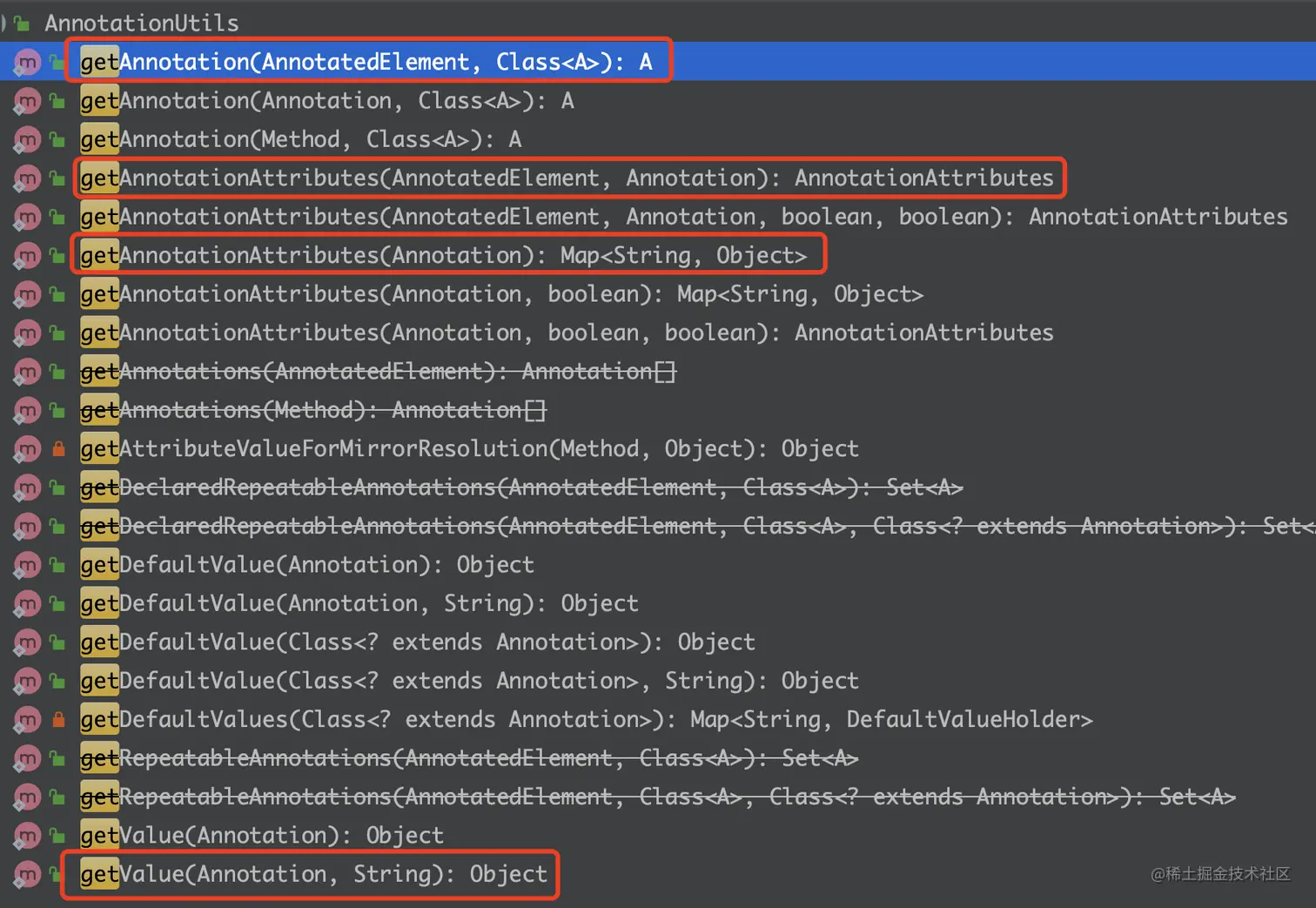
我们来实际使用下这些方法:
// 在 BeanObj3 获取 @Component
Annotation annotation = AnnotationUtils.getAnnotation(BeanObj3.class, Component.class);
if(null == annotation) {
System.out.println("注解不存在!");
return;
}
System.out.println("annotation: " + annotation);
// 获取 AnnotationAttributes
AnnotationAttributes annotationAttributes
= AnnotationUtils.getAnnotationAttributes(BeanObj3.class, annotation);
System.out.println("AnnotationAttributes: " + annotationAttributes);
// 获取 annotationAttributeMap
Map<String, Object> annotationAttributeMap = AnnotationUtils.getAnnotationAttributes(annotation);
System.out.println("annotationAttributeMap: " + annotationAttributeMap);
// 获取value的值
Object value = AnnotationUtils.getValue(annotation, "value");
System.out.println("value: " + value);
结果如下:
annotation: @org.springframework.stereotype.Component(value=123)
AnnotationAttributes: {value=123}
annotationAttributeMap: {value=123}
value: 123
从结果来看,直接通过 AnnotationUtils.getAnnotation(...) 也是能获取到@Component注解的,尽管BeanObj3并没有直接标记@Component.需要注意的是,这样获取到的@Component的value值是"123",并不是@MyComponent设置的beanObj3,这也证明了AnnotationUtils获取属性值时并不进行属性覆盖操作。
4.2 AnnotatedElementUtils
AnnotatedElementUtils支持的部分方法如下:
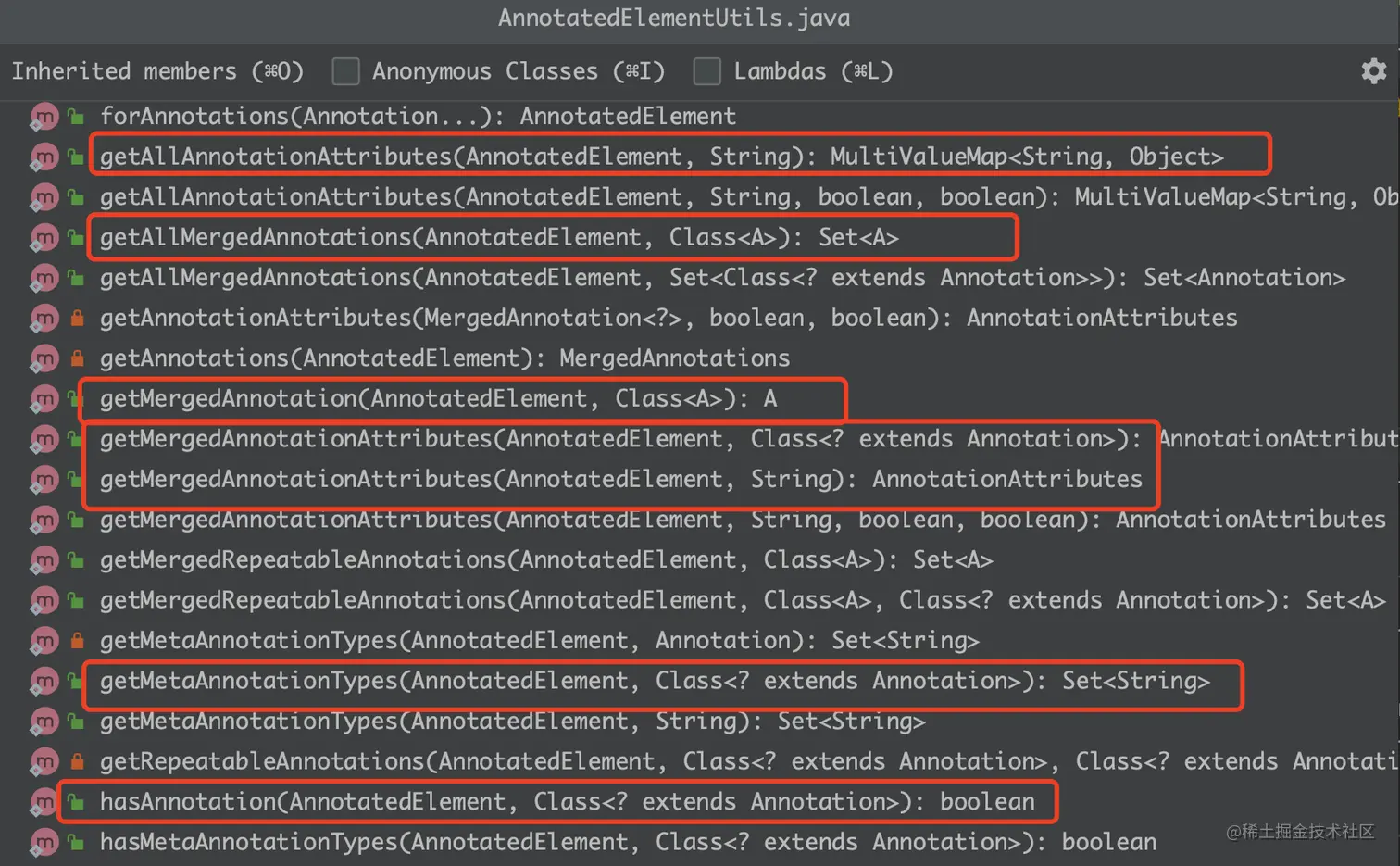
给个示例吧:
// 1. 判断是否有 Component 注解
boolean result = AnnotatedElementUtils.hasAnnotation(BeanObj3.class, Component.class);
System.out.println("hasAnnotation: " + result);
// 2. 获取 attributeMap,可以看到的是,获取 @Component 与 @MyComponent 得到的结果不一样
// Component attributeMap: {value=[123]}
MultiValueMap<String, Object> attributeMap1 = AnnotatedElementUtils
.getAllAnnotationAttributes(BeanObj3.class, Component.class.getName());
System.out.println("Component attributeMap: " + attributeMap1);
// MyComponent attributeMap: {value=[beanObj3]}
MultiValueMap<String, Object> attributeMap2 = AnnotatedElementUtils
.getAllAnnotationAttributes(BeanObj3.class, MyComponent.class.getName());
System.out.println("MyComponent attributeMap: " + attributeMap2);
// 3. 获取所有的 @Component 注解,value=beanObj3
Set<Component> mergedAnnotations = AnnotatedElementUtils
.getAllMergedAnnotations(BeanObj3.class, Component.class);
System.out.println("mergedAnnotations: " + mergedAnnotations);
// 4. 获取属性值,{value=beanObj3}
AnnotationAttributes attributes = AnnotatedElementUtils
.getMergedAnnotationAttributes(BeanObj3.class, Component.class);
System.out.println("attributes: " + attributes);
// 5. 获取 MyComponent 上的注解
Set<String> types = AnnotatedElementUtils
.getMetaAnnotationTypes(BeanObj3.class, MyComponent.class);
System.out.println("types: " + types);
结果如下:
hasAnnotation: true
Component attributeMap: {value=[123]}
MyComponent attributeMap: {value=[beanObj3]}
mergedAnnotations: [@org.springframework.stereotype.Component(value=beanObj3)]
attributes: {value=beanObj3}
types: [org.springframework.stereotype.Component, org.springframework.stereotype.Indexed]
从代码来看,在得到的Set<Component>与AnnotationAttributes中,属性值已经合并了.
在选择使用AnnotationUtils还是AnnotatedElementUtils时,可以根据要不要属性覆盖来选择,如果需要处理属性覆盖,就使用AnnotatedElementUtils,如果不需要,就使用AnnotationUtils吧!
五、总结
本文介绍了spring处理注解的操作,主要介绍了SimpleAnnotationMetadataReadingVisitor与StandardAnnotationMetadata的区别与使用方法。由于这两个类使用起来步骤比较多,文中又介绍了spring提供的两个工具类:AnnotationUtils与AnnotatedElementUtils,如果需要处理属性覆盖,需要使用AnnotatedElementUtils,如果不需要,就使用AnnotationUtils。